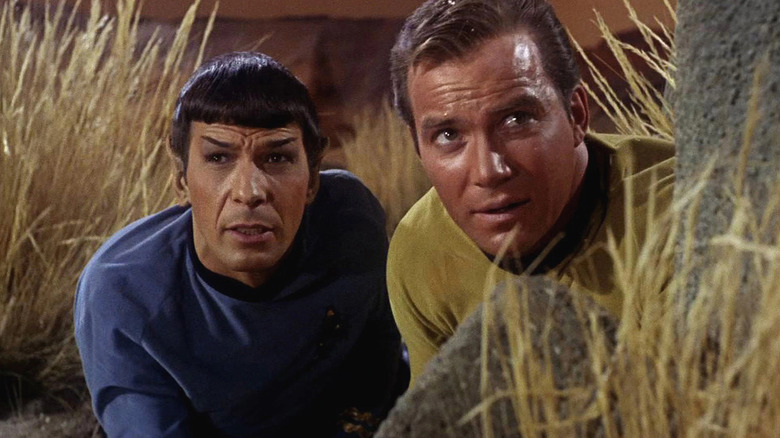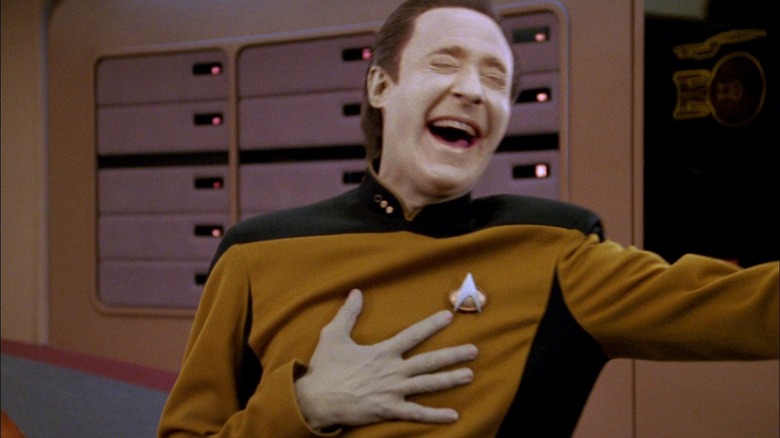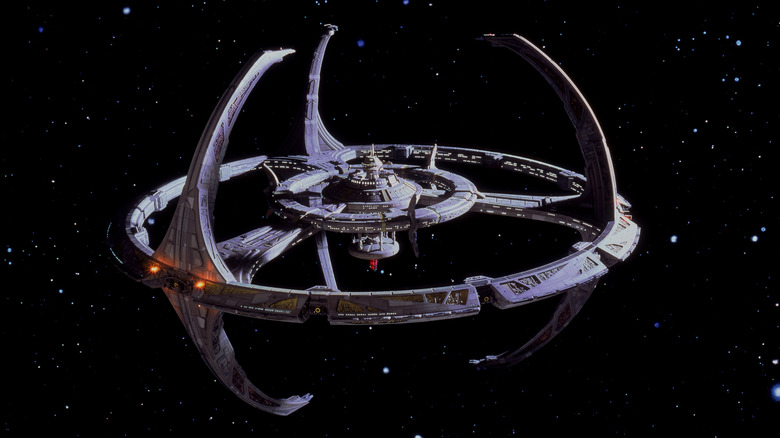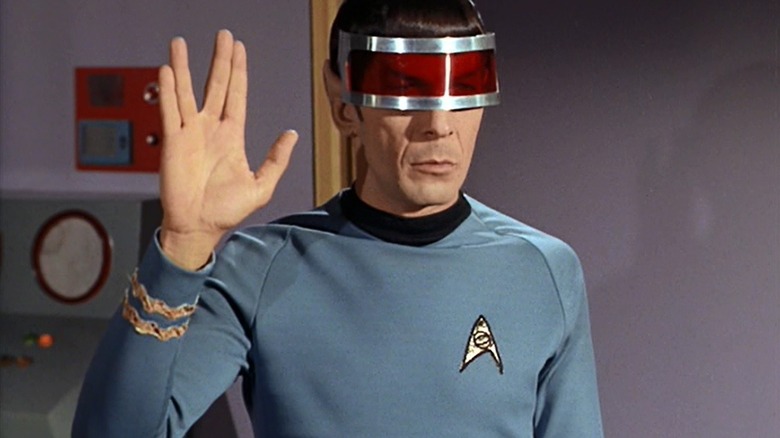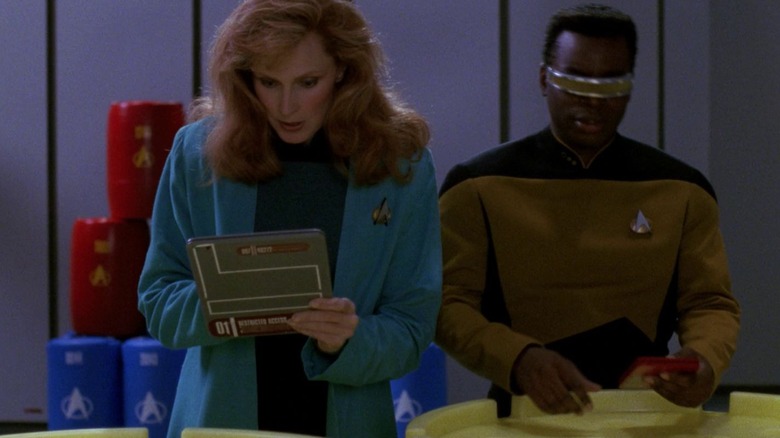A Star Trek Beginner's Guide: Where To Start Watching The Classic Sci-Fi Franchise
The now-iconic sci-fi series "Star Trek" debuted on American television on September 8, 1966, and has been quietly purring underneath all of pop culture ever since. Although the original series went off the air in 1969, the following decade saw the show put into eternal syndication, allowing new audiences to discover it, and for fans to re-watch all their favorite episodes countless times. It was also during the 1970s that Star Trek conventions became an institution and creator Gene Roddenberry began making speaking engagements. In this decade of kibbitzing and lecturing, both the showrunner and the fans came to the mutual conclusion that "Star Trek" was one of the more utopian sci-fi shows to have been produced.
Eventually, in 1979, the show was adapted into a feature film that launched multiple sequels. By 1987, Roddenberry elected to make a spin-off of "Star Trek" which was even more diplomatic and utopian than ever. Beginning with "Star Trek: The Next Generation" and lasting all the way through the end of the 1990s (and two additional spinoffs), the franchise surfed a wave of popularity that seemed unstoppable. By the mid-2000s, however, interest waned, and the Trek came to an end with the cancelation of "Star Trek: Enterprise" in 2005. Thanks to a complicated legal rigmarole, "Star Trek" could only be rebooted as a parallel universe, so the Kelvin continuity temporarily came into being in 2009. That was eight years before the 2017 launch of CBS All Access, and the debut of a new horde (well, six) of Trek programs that only the most passionate of Trekkies can keep up with.
This is all to say there is a metric Spock-ton of Trek in the world, and finding an entry point can be intimidating. But worry not, dear neophyte. We are here to help.
The approach strategy
Exhortation #1: The instinct, of course, is to start at the beginning. With "Star Trek," this is not a good strategy. For one, the original "Star Trek" in 1966 is quite a different animal — tonally and aesthetically — from the Trek of 2022. Secondly, with the exceptions of "Star Trek: The Animated Series" and "Star Trek: Strange New Worlds," none of the Trek shows started strong, often requiring at least a season or two to find their feet, establish characters fully, and start writing more interesting stories. The first piece of advice to "Star Trek" first-timers is, don't start with any of the pilots.
Seriously. They will not do you kindness. They will be fine ways to introduce characters and locations, but Trek pilots rarely feature the show's most intriguing stories.
Exhortation #2. There are many, many celebrated episodes of "Star Trek" that a casual observer might have heard about in casual conversation. "Mirror, Mirror," for instance, is commonly cited as one of OG Trek's better entries. That's the episode with the "evil" parallel universe and with Spock (Leonard Nimoy) sporting a goatee. NextGen fans, meanwhile, might have recommended "The Best of Both Worlds," the two-part cliffhanger episode that bridged seasons three and four. In that story, Capt. Picard (the indomitable Patrick Stewart) was assimilated by the indestructible Borg, and threatened to take over the galaxy. Without question, that is a stellar two hours of TV. But these episodes will have a greater impact on people who are already familiar with the shows in question. These are not really good entry points, as they involve too much pretense and mythos. Another good rule is to stay away from the most popular episodes.
The approach strategy, part II
So while "City on the Edge of Forever" often receives praise as the best "Star Trek" has to offer, it perhaps gains that reputation for standing apart from "Star Trek," not for setting its standard. "City," for those who need it, is the episode wherein Kirk (William Shatner) and Spock travel back in time to the 1940s and meet Edith Keeler (Joan Collins) a woman whose death is fated to, through a complex set of circumstances, stymie the Nazi war effort. In order to return to the future they know, Kirk and Spock must let Edith perish. This is difficult, as Kirk has fallen in love with her. While a great story, "City" might serve better as an episode of "The Twilight Zone" than of "Star Trek." It is certainly no exemplar of the series at large. Do not start with it.
Exhortation #3. It's important to remember that "Star Trek" is, in addition to being a sci-fi utopian musing, a workplace drama. Each one of the shows — "Star Trek: Picard" notwithstanding — takes place in a formal, Starfleet-backed environment. It is a show of command structures, brainstorming, and professionalism. One of the most basic appeals of "Star Trek" is watching intelligent people coming up with interesting solutions to outlandish problems. As such, a neophyte may want to understand what the "baseline reading" of "Star Trek" is before bothering to delve into more intense, deep-cut interpersonal matters or mythology-bending chapters. The broad advice, then, is to stay on the ship or station. See how the characters react on an "everyday" level before leaving the status quo.
The actual episodes to start your journey
Exhortation #4. To date, there have been twelve separate "Star Trek" shows. For a while, it seemed that the franchise was moving steadily forward in time until "Enterprise" threw the timeline back to a century before the original series. Since then, the timeline has been a pick-and-choose affair, with some shows set in the "past" and some shows set in the "present." It wouldn't do one well to watch "Star Trek" in terms of its own chronology, and may be wiser to see any samplings in the order they were released. As such, watch two episodes from the original series first, then two from "The Animated Series," then two from "The Next Generation" and so on.
From "Star Trek": Watch "The Trouble with Tribbles" and "Is There in Truth No Beauty?" One is a comedic episode, but is very much about the more boring side of Starfleet diplomacy. Kirk, an otherwise steadfast man of action, has to oversee a grain shipment that may be infested with vermin called Tribbles. An issue is that Tribbles are adorable. Kirk is exasperated. It's "Star Trek" through and trough. "Is There in Truth No Beauty?" is about a species of aliens, the Medusans, so strange that their appearances makes most humanoids go mad. It's an episode about the nature of bodies, and the limitless possibilities of life in the galaxy.
From "The Animated Series, one must bend the rules by starting with the pilot: Watch "Beyond the Farthest Star" followed by "How Sharper Than a Serpent's Tooth."
Moving forward
From "The Next Generation," one can get some good philosophy, as well as a good ensemble piece. Watch "The Measure of a Man," the one where the consciousness of android Data (Brent Spiner) is put on trial, followed by "Disaster," which is more or less "The Poseidon Adventure" in space.
For "Deep Space Nine," what some consider "the best Trek of all time," definitely start with "Duet," a great moral tale about Maj. Kira (Nana Visitor) confronting a Cardassian war criminal, and the arguments he makes about the need for occupation. Then watch "Civil Defense," a similarly disaster-forward episode where the crew of the titular station triggers an old security protocol that keeps them trapped by the fascists that used to run the place.
Following those eight episodes, one should have a good feel for "Star Trek" at large, and might already have found favorite characters, settings, or scenarios. At this point, one might want to start exploring a little on their own randomly throughout the first four shows, looking for anything that might interest them. Follow your heart. You might find something good or bad, but you'll know where you are now. Just stay away from "Turnabout Intruder," "The Alternative Factor," "Code of Honor," and "Shades of Gray."
If one is brave, they can then go forward with "Voyager," then "Enterprise." That, however, might be considered the 200-level course. The Paramount+ era will require its own intro.
